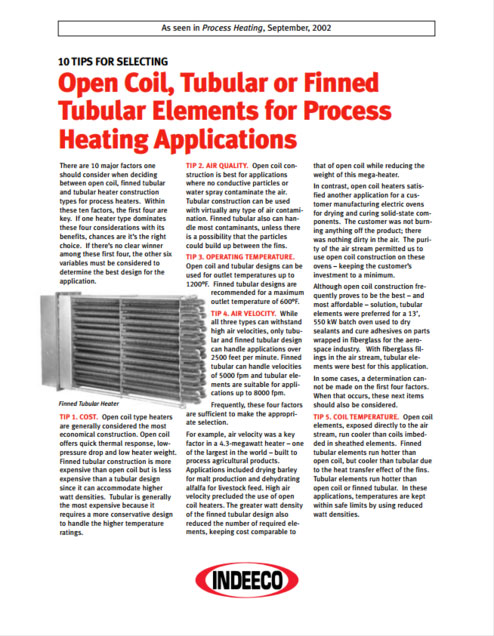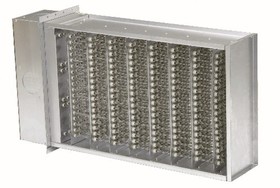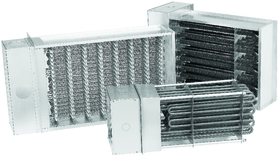
As seen in Process Heating, September, 2002
There are 10 major factors one should consider when deciding between open coil, finned tubular and tubular heater construction types for process heaters. Within these ten factors, the first four are key. If one heater type dominates these four considerations with its benefits, chances are it’s the right choice. If there’s no clear winner among these first four, the other six variables must be considered to determine the best design for the application.
TIP 1. COST.
Open coil type heaters are generally considered the most economical construction. Open coil offers quick thermal response, lowpressure drop and low heater weight. Finned tubular construction is more expensive than open coil but is less expensive than a tubular design since it can accommodate higher watt densities. Tubular is generally the most expensive because it requires a more conservative design to handle the higher temperature ratings.
TIP 2. AIR QUALITY.
Open coil construction is best for applications where no conductive particles or water spray contaminate the air. Tubular construction can be used with virtually any type of air contamination. Finned tubular also can handle most contaminants, unless there is a possibility that the particles could build up between the fins.
TIP 3. OPERATING TEMPERATURE.
Open coil and tubular designs can be used for outlet temperatures up to 1200°F. Finned tubular designs are recommended for a maximum outlet temperature of 600°F.
TIP 4. AIR VELOCITY.
While all three types can withstand high air velocities, only tubular and finned tubular design can handle applications over 2500 feet per minute. Finned tubular can handle velocities of 5000 fpm and tubular elements are suitable for applications up to 8000 fpm. Frequently, these four factors are sufficient to make the appropriate selection. For example, air velocity was a key factor in a 4.3-megawatt heater – one of the largest in the world – built to process agricultural products. Applications included drying barley for malt production and dehydrating alfalfa for livestock feed. High air velocity precluded the use of open coil heaters. The greater watt density of the finned tubular design also reduced the number of required elements, keeping cost comparable to that of open coil while reducing the weight of this mega-heater.
In contrast, open coil heaters satisfied another application for a customer manufacturing electric ovens for drying and curing solid-state components. The customer was not burning anything off the product; there was nothing dirty in the air. The purity of the air stream permitted us to use open coil construction on these ovens – keeping the customer’s investment to a minimum.
Although open coil construction frequently proves to be the best – and most affordable – solution, tubular elements were preferred for a 13’, 550 kW batch oven used to dry sealants and cure adhesives on parts wrapped in fiberglass for the aerospace industry. With fiberglass filings in the air stream, tubular elements were best for this application. In some cases, a determination cannot be made on the first four factors. When that occurs, these next items should also be considered.
TIP 5. COIL TEMPERATURE.
Open coil elements, exposed directly to the air stream, run cooler than coils imbedded in sheathed elements. Finned tubular elements run hotter than open coil, but cooler than tubular due to the heat transfer effect of the fins. Tubular elements run hotter than open coil or finned tubular. In these applications, temperatures are kept within safe limits by using reduced watt densities.
TIP 6. PRESSURE DROP.
The less space occupied in the heater by elements, the lower the pressure drop. Therefore, heaters with open coil elements have the lowest pressure drop. Finned tubular elements will have a higher pressure drop than open coil, but tubular elements have the highest pressure drop due to the higher percentage of space occupied in the heater.
TIP 7. ELECTRICAL CLEARANCES.
Tubular and finned tubular elements have relatively small clearances between their live parts (the resistance wire) and the sheath, but this space is filled with compacted magnesium oxide which acts as insulation. Open coil heaters are better suited to withstand severe applications since there is a large clearance between the live parts of the heating element and ground.
TIP 8. SAFETY.
Because the live coil is enclosed in a metal sheath, shock hazard due to accidental contact is eliminated in tubular and finned tubular elements. If there is a possibility that conductive material or personnel may come in contact with the element, open coil heaters are not recommended since they are electrically live.
TIP 9. AIRFLOW UNIFORMITY.
A perfect application has airflow uniformly distributed throughout the heater. Open coil heaters are not tolerant of hot spots and must have uniform airflow to operate properly. If necessary, pressure plates can be used to even out the airflow. Finned tubular elements are most tolerant of nonuniform airflow situations. Hot spots tend to be dissipated by the sheath and fin design. Tubular elements are more tolerant of uneven airflow, but not to the same degree as finned tubular elements.
TIP 10. CONTROLLABILITY.
Open coil heaters have a low thermal inertia which results in quick response to step control. This can cause temperature fluctuations unless the controls compensate. Finned tubular elements have a high thermal inertia which results in slower response but can produce more uniform temperatures if the control system is properly designed. Tubular elements would react somewhere between the other two. Every application is unique, and warrants an individual solution. In the long run, it’s worth the time to research the best possible type of construction for each process air application.

